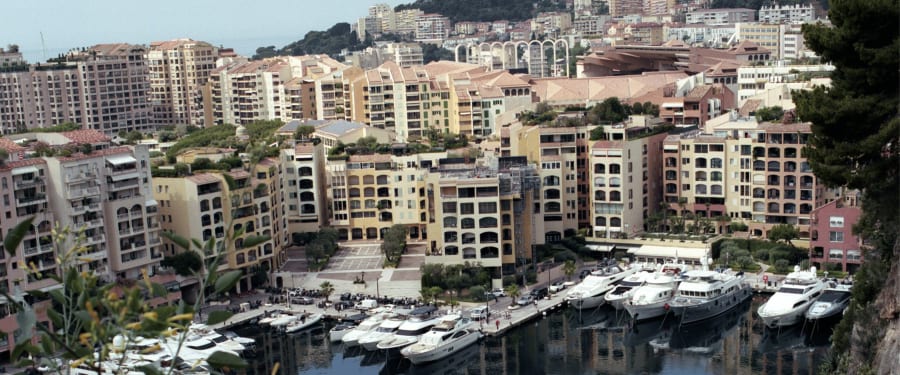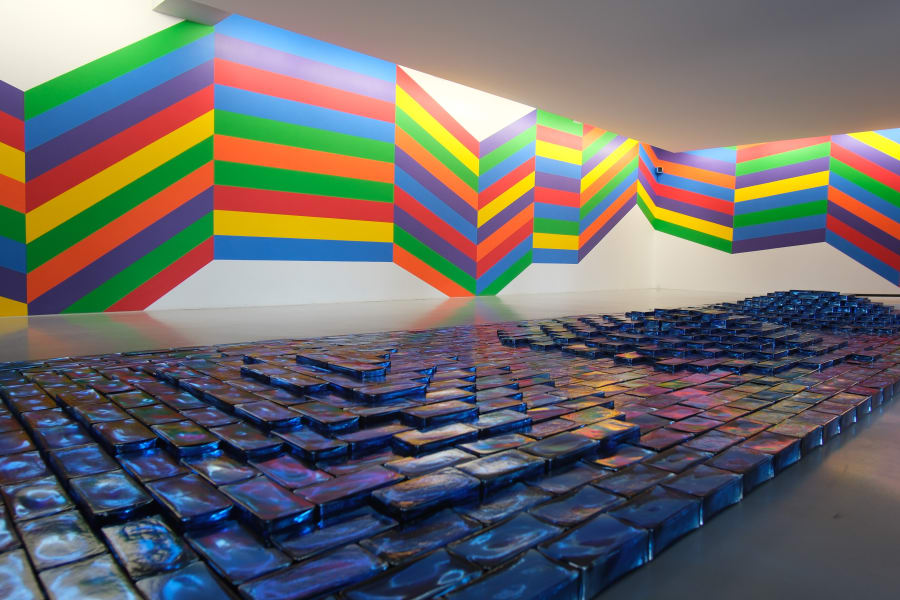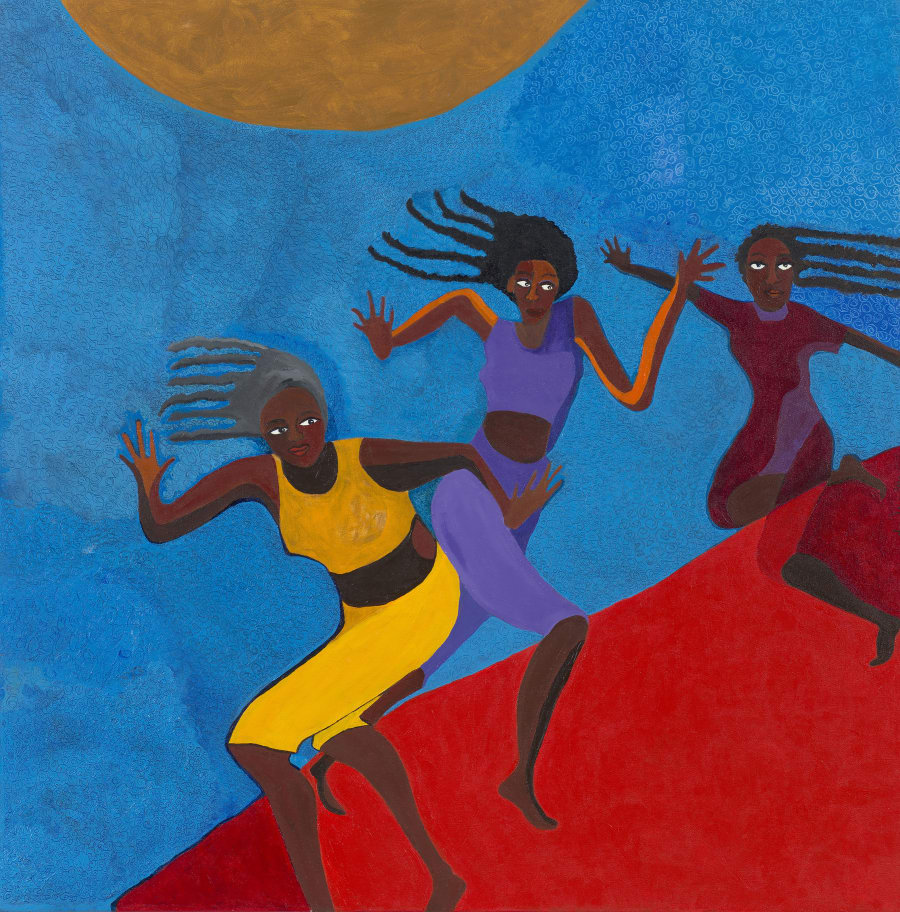Through the end of August, the Fondation Louis Vuitton in Paris dedicates all 11 of its galleries over to an icon: David Hockney. The British artist, born in 1937, presents his largest retrospective to date, following on in France from the one hosted by the Centre Pompidou in 2017. ‘David Hockney 25’ presents the full scope of his pictorial research – as playful as it is erudite – through 400 works made between 1955 and 2025. The exhibition provides the opportunity to revisit lesser-known aspects of his career.
His reinvention of perspective leads him all the way to China
For Hockney, the linear perspective of the Renaissance is too rigid and so, throughout his career, the artist has sought to break free from this, in order to better translate the sensations of a spectator in movement. It was in the early 1980s that Hockney developed his principle of ‘reverse perspective’ after discovering Chinese asymmetrical perspective. He then undertook a journey through China tracing the path of a mysterious 18th-century Chinese scroll, about which he would make the documentary ‘A Day on the Grand Canal with the Emperor of China or: Surface Is Illusion But So Is Depth’ (1988).
His technophilia dates back to the 1980s
Hockney constantly reinvents himself, as evidenced by his ‘flower portraits’ created on an iPad, starting in 2011. Less well known is the fact that the artist had already experimented with fax (1989), computer (1990), and graphics tablet (2008). The triggering event dates back to an exhibition at London’s Victoria and Albert Museum which, in 1972, had organized a photography exhibition entitled ‘From Today Painting is Dead’. Hockney would henceforth work to demonstrate the opposite: The innovative use of new technologies proves, on the contrary, the vitality of painting.
He loves Polaroids as much as he loves Picasso
Hockney discovered Polaroids in the early 1980s. The artist, marked by his discovery of Pablo Picasso’s work when he was a student, immediately perceived a resonance with Cubism. He then began creating his ‘joiners’ – collages assembled from multiple shots of the same subject. Pearblossom Highway (1986) is the last work from this period and perhaps the most emblematic: a mosaic of an arid California desert road, created from about a hundred photographs.
Opera allows him to escape pictorial impasses
Hockney’s passion for opera has run the course of his career. From his beginnings, the polymath created sets and costumes that he called ‘paintings on stage,’ notably for Alfred Jarry’s Ubu Roi (1966), Igor Stravinsky’s The Rake's Progress (1975), and Mozart’s The Magic Flute (1978). These creations have also been a way for him to renew his pictorial vocabulary at moments of crisis. At the Fondation Louis Vuitton, the artist wished to dedicate gallery 10 to opera.
His swimming pools celebrate homoerotic joy
In 1963, Hockney flew to Los Angeles for the first time. From the plane, he observed the turquoise expanses of water streaked with flashes of light. One of his favorite themes was born. He painted Picture of a Hollywood Swimming Pool (1964), Peter Getting Out of Nick's Pool (1966), The Splash and A Little Splash (both 1966), and then A Bigger Splash (1967). It was a pictorial challenge but also a celebration of homoerotic leisure – homosexuality would not be decriminalized until 1967 in his native England.
He restored the double portrait to its former glory
Hockney’s portraits are among his most popular works. The Fondation Louis Vuitton presents about 50 of them, showcasing an intimate gallery of friends and loved ones. Hockney particularly favors the genre of the double portrait. This tradition is illustrated in art history by paintings like Jan van Eyck’s The Arnolfini Portrait (1434), Thomas Gainsborough’s Mr and Mrs Andrews (1750), or William Hogarth’s A Rake's Progress (1732–34). The genre nonetheless remained uncommon in the contemporary era until Hockney took it on. He made Mr and Mrs Clark and Percy (1970-1971), a vibrant ode to London’s fashion milieu.
He spent lockdown in Normandy, France
Hockney is often associated with the UK or California. But the artist could also be considered Norman, having taken up residence in the Pays d’Auge from 2019 to 2023. It was there, surrounded by verdant fields, that he created the landscape series 220 for 2020. Every day, Hockney catalogued on his iPad the changing of the seasons. While the world was closing in during the health crisis, he drew from it the following message of hope: ‘Do remember they can’t cancel the spring.’ During the exhibition, the phrase is inscribed in pink neon on the façade of the Fondation Louis Vuitton.
'David Hockney 25'
Until August 31, 2025
Fondation Louis Vuitton, Paris.
David Hockney is represented by the galleries Annely Juda Fine Art in London, Gray in Chicago, Galerie LeLong in Paris, L.A. Louver in Venice, and Pace Gallery in New York.
Ingrid Luquet-Gad is an art critic and PhD candidate based in Paris. She teaches art philosophy at the University Paris 1 Panthéon-Sorbonne.
English translation: Art Basel.
Caption for header image: Installation view of Bigger Trees near Warter or ou Peinture sur le Motif pour le Nouvel Âge Post-Photographique (2007) by David Hockney, in the exhibition "David Hockney 25" at the Fondation Louis Vuitton, Paris, 2025.Photograph by Prudence Cuming Associates Tate, United Kingdom. Courtesy of the artist. © David Hockney.
Published on July 14, 2025.


